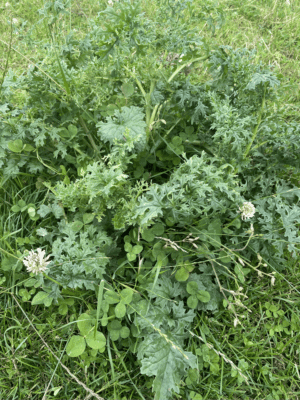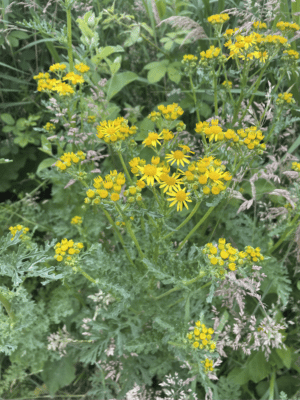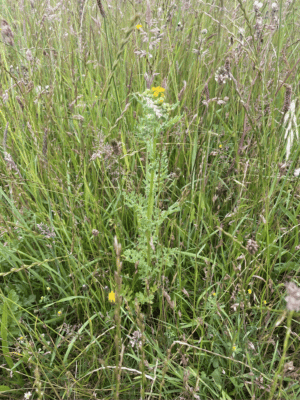Nutrition
Ragwort!
Briony Witherow, gives us the lowdown on the scourge of equine pasture – ragwort!
Ragwort is common in horse pastures throughout the UK and thrives where grass has been overgrazed. In certain years, ragwort may appear more prolific than others, with certain environments and weather conditions (notably wet springs and summers), favouring its growth and replication.
As a biennial plant (flowering in its second year), a year where ragwort is seen to thrive is typically a product of the preceding year’s weather. While this may explain a year of prolific ragwort there are many other factors at play, so weather conditions alone should not inform frequency of management. To complicate matters further, if ragwort is damaged or disturbed (common in horse pastures through trampling), ragwort can persist beyond this two-year cycle (plants unable to flower instead putting their efforts into supplementary spreading via fragmented roots).
Besides being poisonous to our horses, ragwort presents such a big problem simply because it is incredibly hard to completely remove and, is very effective at spreading; reproducing principally through dispersal of seeds (which can remain viable in the soil for a few years, reappearing if the soil is disturbed) but also from root fragments from a growing plant or those that may remain when a plant is hand-pulled. Wherever you are in the UK, you will have come across ragwort; when it comes to controlling it in our pastures, being clear on how to identify, remove and dispose, is fundamental to long-term management.
Identification
There are various types of ragwort that can be found in the UK including; common ragwort (Senecio jacobaea) flowering June to November; hoary ragwort (Senecio erucifolius) flowering from July to August (mainly found in the South and East of the UK); marsh ragwort (Senecio aquaticus) which, as the name would suggest favours wet areas and flowers from June to September and, Oxford ragwort (Senecio squalidus), widespread in the UK, flowering April to November. Much of the research relating to ragwort concerns common ragwort but, the general management advice applies to all.
When it comes to identifying ragwort, the good news is that although there are subtle differences between the various ‘strains’ there are some common defining features to look out for. As mentioned previously, common ragwort is typically biennial, meaning that it flowers every two years, hence the need for continual management. This also means that you will need to be familiar with identifying ragwort in its ‘vegetative’ (still growing or rosette stage) as well as at flowering. The latter is much easier due to the distinctive bright yellow flowers which are evident from June to October.

During the growing stage, ragwort forms a green rosette (circular arrangement of leaves), which have a characteristic ‘curly’ or ‘jagged edge’. This stage can be more challenging to identify (see figure 1) and in the plant’s second year a flower stem is formed, and a yellow flower produced.
These flowers are ‘daisy-like’ in their structure and sit upon stems 30-100cm tall with dark green jagged leaves and brighter green stems (sometimes tinged red near the base) (see figure 2).
Later, from July to August, the seeds of the ragwort plant will mature and start to shed from September. As a single plant can produce thousands of seeds it is crucial where at all possible to eradicate ragwort from pasture before this point to reduce spread in years to come (see figure 3).
Short term management
Ragwort is a deep rooting plant, helping it to spread quickly and, making it harder to remove. One option to control ragwort is to apply herbicide, which is most effective in the first year of growth (rosette/vegetative stage) in the spring. Horses will need to be removed from pasture post application (period dependant on product used) and most products will need to be applied by a qualified contractor/individual (holding PA1 and PA6 application by knapsack or PA2 boom sprayer (ATV or tractor) qualification). Qualified contractors can be sought locally, and the NAAC hold a list of qualified contractors and provides a good starting point (https://www.naac.co.uk/findacontractor/).

As ragwort can be more palatable when it has wilted or decayed, it is imperative that horses are not returned to pasture until ragwort has either fully decayed or been removed. Depending on the product and maturity of the ragwort, herbicides can be applied at the end of the grazing season (September-November) to help control vegetative plants (rosette stage) the following year – this may be an option (alongside removing more mature plants by hand) for those where ‘no grazing’ periods are hard to facilitate over spring and summer or as part a strategic approach where extensive ragwort burdens exist.
More mature ragwort plants are less easy to control with herbicides and therefore may require removingby hand. Hand-digging ragwort is not always feasible for large areas or heavy infestations and needs to be comprehensive (removing the entire root) to be successful. Due to ragwort being able to regenerate from root fragments alone, it is possible to exacerbate the problem through incomplete removal of plants. This job is considerably easier when the soil is damp and can be further helped by forks specifically designed for the removal of ragwort.
Whenever dealing with ragwort, gloves should be worn and plants disposed of appropriately. Methods of disposal include controlled burning (suitable for small quantities); or disposing via a waste-management company. As ragwort can still go to seed after it’s been removed from pasture, whatever the means of disposal, it is essential that the ragwort is enclosed in a paper feed bag (or similar).
Long term management

Good pasture management is key to preventing unwanted weeds such as ragwort, appearing in your fields. Key steps towards good pasture management include: Avoid over-stocking and overgrazing to minimise compaction, and give grass chance to ‘rest’. This should help to avoid bare patches that give weeds an opportunity to get established. Healthy soil and therefore healthy grass means less weeds. Most weeds tend to thrive in conditions where grass does not. Optimising the soil condition to suit grass by checking the pH (how acid or alkaline the soil is) and nutrient levels (fertility of the soil) can be beneficial. Grass will typically thrive at a soil pH of between 6-7 and needs relatively fertile soil, to reduce ‘stress’ and encourage ground cover.
- Get planning. The more proactive you can be about grassland management, the more you are likely to get from your grass – if you can secure more nutrition (grass) from your pasture, this means you will be less reliant on bucket feed, and additional hay or haylage throughout the year.
- Take action to control ragwort now to prevent this year’s mature plants from becoming next year (or the following years) seedlings.
- Remember that ragwort is less likely to be consumed in its growing form (unless there is no alternative) and the more common source of ragwort poisoning is through hay or haylage. Use this time of year to also review your forage supplier.
